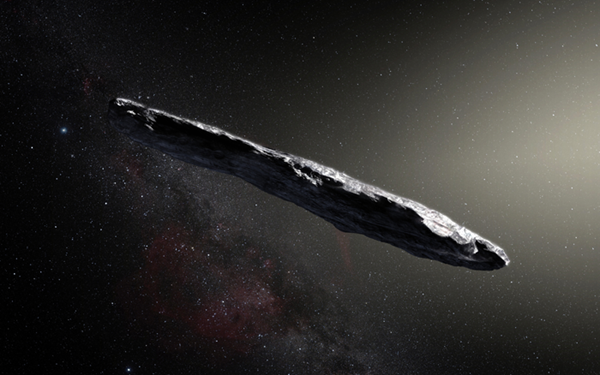Given a Hawaiian name by its Maui-based discoverers, the object is called ‘Oumuamua, meaning either “scout,” or “messenger sent from the distant past.” Finding the first-ever object to arrive from the stars would be reason enough to get excited. But, it turned out, the fun was just beginning.
First, the asteroid’s high speed meant it wouldn’t be captured by the Sun, but flung back into interstellar space on some new heading. Its outgoing trajectory was inclined 66° from its original incoming direction, which was in the vicinity of the star Vega. (Yes, Vega, where the aliens lived and Jodie Foster’s character visited in the movie Contact. So maybe that flick was a true story.)
Anyway, if this oddly shaped object, with its longest dimension between one and 10 city blocks, is of natural origin, then coming from Vega’s direction makes sense. That’s just a few degrees from the solar apex, the direction toward which our solar system is moving. You experience the most things crashing into you when you’re heading in their direction, like when you drive through falling rain or snow.
But Vega wasn’t even in that location 600,000 years ago when — based on tracing its velocity backward — ‘Oumuamua would have been there. Instead, it probably came from one of four dwarf red stars. It was in the vicinity of a bunch of such young stars some 45 million years ago. ‘Oumuamua may have been expelled during its solar system’s early formative years, which would explain its relatively slow speed for an interstellar voyager.
The UFO explanation is simply that it’s a spacecraft and when it finished visiting us, it turned on its rockets. But there are two natural alternatives. ‘Oumuamua might be outgassing the way comets do when they approach the Sun, and such venting acts like a booster rocket. We’ve seen that happen in solar system comets. Or ‘Oumuamua could be catching the solar wind like a sail, getting a speed boost that way.
But for the solar sail idea to work, it must be very lightweight for its size. In other words, it must be thin — so thin that if ‘Oumuamua were a solar sail, it probably couldn’t stand the stress imposed by the fact it’s tumbling end over end every eight hours. Plus, a tumbling solar sail wouldn’t work.
So it’s probably not a solar sail. But the question remains: Was ‘Oumuamua sending back images of us? Given its odd shape and unique origin, the Green Bank radio telescope monitored ‘Oumuamua on December 13, 2017, across four broad frequencies. About two weeks before that, the SETI Institute’s Allen Telescope Array began monitoring it, too, for a total of at least 60 hours. The result: silence. Any emissions from ‘Oumuamua must be weaker than 8/100 of a watt — that’s a fraction of a night light’s energy.
‘Oumuamua remains singular. It has the same dark red color as many Kuiper Belt objects, and yet Spitzer Space Telescope observations show it is “at least ten times more shiny than the typical asteroids in the solar system,” Harvard University professor of science Abraham Loeb wrote in an email to Universe Today. Curiouser and curiouser. So curious, in fact, that Loeb and fellow Harvard researcher Shmuel Bialy came right out and, violating Occam’s razor, said that it could be an artificial object.
Meanwhile, just as the first known periodic comet (Halley) received the brand-new designation “P” and is classified to this day as 1P, ‘Oumuamua inspired the new category “I” for “interstellar object” and had its designation changed to 1I.
So, now what? The Initiative for Interstellar Studies launched Project Lyra in October 2017 to appraise the possibility of sending a spacecraft to catch up with ‘Oumuamua. Its conclusion: With a Jupiter slingshot boost, a SpaceX Falcon Heavy rocket could reach the strange object in five to 10 years and take a close look and maybe end the guesswork.
Should we do that? Funding such a mission might come down to how much the public wants to know about this visitor from another star.











